An Oriental rug is Hand woven and varies in quality. Quality is generally determined by the wool, intricacy of design, and knot density. Wool quality is defined by the length of its fibers, springiness, and luster. Today, the wool used in Hand knotted Oriental rugs either originates exclusively from the country of origin or is a blend of indigenous and imported wool. Intricacy of design refers to the degree of detail a design possesses as well as to the number of different colors needed to execute the pattern. The more complex the design, the more experienced the craftsman must be to weave the pattern. Finally, knot density and fineness of weave are synonymous. The more knots tied per square inch, the finer the detail in the design and the more labor-intensive the production.
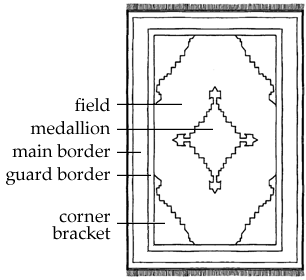
Handmade Oriental Area Rugs
AN INTRODUCTION FOR THE CONSUMER
Historical Perspective
The art of carpet weaving existed in Iran in ancient times, according to evidence such as the 2500-year-old Pazyryk carpet, dating back to 500 B.C., during the Achaemenid period The first documented evidence on the existence of Persian carpets came from Chinese texts dating back to the Sassanid period (224 – 641 AD).
This art underwent many changes in various eras of the Iranian history to an extent that it passed an upward trend before the Islamic era until the Mongol invasion of Persia.
With the passage of time, the materials used in carpets, including wool , silk and cotton , will decay. Therefore archaeologists are rarely able to make any particularly useful discoveries during archaeological excavations. What has remained from early times as evidence of carpet-weaving is nothing more than a few pieces of worn-out carpets.
Dramatic changes have occurred in today’s handmade Oriental carpet industry. Although weaving techniques and traditions have remained virtually unchanged, the weavers have found it more advantageous to adapt designs and colors to better satisfy Western decorative tastes. Moreover, throughout the 1980s, the production of Persian-design carpets in other countries, particularly India, China, Pakistan, and Rumania has increased significantly, offering consumers an ever-wider range of color and design choices available in a full range of prices.
Islamic period
From the Yarn fiber to the colors, every part of the Persian carpet is traditionally hand-made from natural ingredients over the course of many months. This arduous process is shown in the Japanese/Iranian film . In the 8th century A.D.A Azerbaijan Province was among the largest centers of carpet and rough carpet (ziloo) weaving in Iran. The Province of Tabaristan, besides paying taxes, sent 600 carpets to the courts of caliphs in Baghdad every year. At that time, the main items exported from that region were carpets, and small carpets for saying Prayers (also known as prayer mats). Furthermore, the carpets of Khorasan, and Bukhara, because of their prominent designs and motifs, were in high demand among purchasers. The most famous Persian carpet from this period is a large Safavid (1501–1736) example known as the Ardabil Carpet, in the Victoria and Albert Museum in London, which in fact is now a combination of two original carpets, with another piece from the second in Los Angeles .This has been the subject of endless copies ranging in size from small to full scale). There is much variety among classical Persian carpets of the 16th and 17th century. There are numerous sub-regions that contribute distinctive designs to Persian carpets of this period such as Tabriz.
The Fundamentals of Rug Making
Although some of the special techniques involved in weaving an Oriental rug may vary from country to country and even from one region to another, the principles of rug-making — from dyeing the yarn to shearing the finished piece — are virtually the same throughout the world and have changed very little over the centuries. Still, a basic understanding of an Oriental rug’s construction will be invaluable to you when selecting an Oriental rug. By and large, most Oriental rugs feature a wool pile, mainly derived from sheep, whose quality depends on factors such as the animal’s breed and diet, local climate, and shearing season. After shearing, the wool is washed, carded (i.e., a teasing process that straightens the fibers), and then hand – or machine – spun into yarn. Next, the yarn is dyed in an attractive range of colors and then dried slowly in the sun.
Knots
Two basic knots are used in most Persian Carpets and Oriental Rugs: the symmetrical Turkish or Ghiordes knot (used in Turkey, the Caucasus, East Turkmenistan, and some Turkish and Kurdish areas of Iran), and the asymmetrical Persian or Sennah knot (Iran, India, Turkey, Pakistan, China, and Egypt).
Turkish knot
the yarn is passed between two adjacent warps, brought back under one, wrapped around both forming a collar, then pulled through the center so that both ends emerge between the warps.
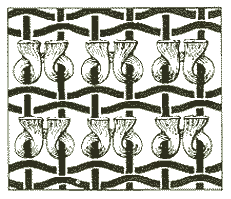
Persian knot
is used for finer rugs. The yarn is wrapped around only one warp, then passed behind the adjacent warp so that it divides the two ends of the yarn. The Persian knot may open on the left or the right, and rugs woven with this knot are generally more accurate and symmetrical.
Other knots include the Spanish knot looped around single alternate warps so the ends are brought out on either side or the Jufti knot which is tied around four warps instead.
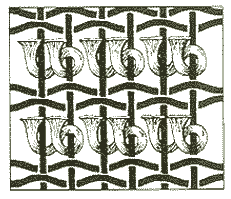
How to Count the Knots of Hand knotted Carpets
Counting knots on an oriental rug is easy to learn. Unfortunately most “expert” knot counters do not realize one knot is often counted as two knots and with the use of unpled strands of yarn, one knot has been mistaken for eight knots or more. We must first learn what one knot looks like from the rugs back.
Every Persian and Turkish Knots Has two loops but only some rugs show both. Most rugs show only one of the loops. A few rugs show one loop but just part of the other loop.
Before counting knots we must be sure we are counting each knot only once.

Materials
Wool is the most common material for carpets but cotton is frequently used for the foundation of city and workshop carpets. There are wide varieties in types of wool used for weaving. Those of which include Kork wool, Manchester wool, and in some cases even camel hair wool. Silk carpets date back to at least the sixteenth century in Sabzevar and the seventeenth century in Kashan. Silk carpets are less common than wool carpets since silk is more expensive and less durable; they tend to increase in value with age. Due to their rarity, value and lack of durability, silk carpets are often displayed on the wall like tapestries rather than being used as floor coverings.
Designs, motifs, and patterns
Persian rugs are made up of a layout and a design which in general included one or a number of motifs. The Iran Carpet Company, a specialist in the subject, has attempted to classify Persian carpet designs and has carried out studies of thousands of rugs. Their results show that there have been slight alterations and improvements to almost all original designs. In its classification the company has called the original designs as the ‘main pattern’ and the derivatives as the ‘sub patterns’.
HOW TO DIFFERENTIATE A MACHINE MADE ‘ORIENTAL DESIGN’ RUG
1. Machine stitching can always be found along both sides of the rug.
2. The stitching is normally dued to make it less noticeable.
3. The design is often vague and indistinct.
4. The back is covered with perfectly straight lines.
The fringe is almost always sewn on and not an extension of the warp.
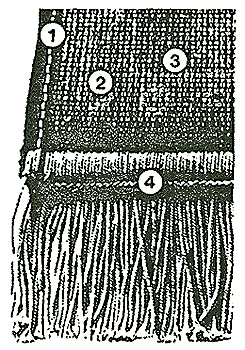
Hand Knotted Rug
Warp
The parallel threads running through the entire length of the rug onto which the knots are tied.
Weft
The threads running across the width of the rug inserted between all the rows of knots. These threads pass through alternate warp threads. Their job is to secure the knots in parallel lines and to strengthen the fabric.
Knot
The term used for a strand of wool yarn which is looped around two adjacent warp threads and then cut to form the pile (surface of carpet).
Fringe
The visible continuation of the warp threads at both ends of the carpet.
Kilims
The pile less web of warp and weft between the rug’s pile and the knotted fringe. This is also the name for a rug without pile.
Techniques and structures
weaving process
The weaving of pile rugs is a difficult and tedious process which, depending on the quality and size of the rug, may take anywhere from a few months to several years to complete.
To begin making a rug, one needs a foundation consisting of warps strong, thick threads of cotton, wool or silk which run the length of the rug and wefts similar threads which pass under and over the warps from one side to the other. The warps on either side of the rug are normally combined into one or more cables of varying thickness that are overcast to form the selvedge.
Weaving normally begins by passing a number of wefts through the bottom warp to form a base to start from. Loosely piled knots of dyed wool or silk are then tied around consecutive sets of adjacent warps to create the intricate patterns in the rug. As more rows are tied to the foundation, these knots become the pile of the rug. Between each row of knots, one or more shots of weft are passed to tightly pack down and secure the rows.
Depending on the fineness of the weave, the quality of the materials and the expertise of the weavers, the knot count of a Handmade rug can vary anywhere from 16 to 550 knots per square inch.
When the rug is completed, the warp ends form the fringes that may be weft-faced, braided, tasseled, or secured in some other manner.
Looms
Looms do not vary greatly in essential details, but they do vary in size and sophistication. The main technical requirement of the loom is to provide the correct tension and the means of dividing the warps into alternate sets of leaves. A shedding device allows the weaver to pass wefts through crossed and uncrossed warps, instead of laboriously threading the weft in and out of the warps.
Horizontal looms
The simplest form of loom is a horizontal; one that can be staked to the ground or supported by sidepieces on the ground. The necessary tension can be obtained through the use of wedges. This style of loom is ideal for nomadic people as it can be assembled or dismantled and is easily transportable. Rugs produced on horizontal looms are generally fairly small and the weave quality is inferior to those rugs made on a professional standing loom.
Vertical looms
Vertical looms are undoubtedly more comfortable to operate. These are found more in city weavers and sedentary peoples because they are hard to dismantle and transport. There is no limit to the length of the carpet that can be woven on a vertical loom and there is no restriction to its width.
There are three broad groups of vertical looms, all of which can be modified in a number of ways: the fixed village loom, the Tabriz or Bunyan loom, and the roller beam loom. The fixed village loom is used mainly in Iran and consists of a fixed upper beam and a moveable lower or cloth beam which slots into two sidepieces. The correct tension is created by driving wedges into the slots. The weavers work on an adjustable plank which is raised as the work progresses.
Tools
In order to operate the loom, the weaver needs a number of essential tools: a knife for cutting the yarn as the knots are tied; a comb-like instrument for packing down the wefts; and a pair of shears for trimming the pile. In Tabriz the knife is combined with a hook to tie the knots which lets the weavers produce very fine rugs, as their fingers alone are too thick to do the job.
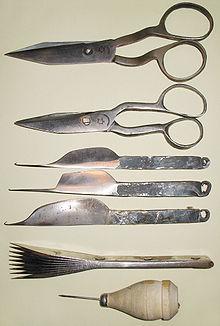
A variety of instruments are used for packing the weft. Some weaving areas in Iran known for producing very fine pieces use additional tools. In Kerman, a saber like instrument is used horizontally inside the shed, and in Bijar a heavy nail-like tool is used. Bijar is also famous for their wet loom technique, which consists of wetting the warp, weft, and yarn with water throughout the weaving process to make the elements thinner and finer. This allows for tighter weaving. When the rug is complete and dried, the wool and cotton expand to make the rug incredibly dense and strong.
Afghan Kilims
History
As kilims are much less durable than rugs that have a pile to protect the warp and weft, it is not surprising that few of great age remain. The weave is almost identical with that of modern kilims, and has about fourteen threads of warp and sixteen threads of weft to the inch. The pattern consists of narrow stripes of blue, green, brownish yellow, and red, containing very small geometric designs. With this one exception, so peculiarly preserved, there are probably very few over a century old.
Weaving technique
Kilims are produced by tightly interweaving the warp and weft strands of the weave to produce a flat surface with no pile. Most kilim weaves are “weft-facing”, i.e., the horizontal weft strands are pulled tightly downward so that they hide the vertical warp strands.
When the end of a color boundary is reached, the weft yarn is wound back from the boundary point. Thus, if the boundary of a field is a straight vertical line, a vertical slit forms between the two different color areas where they meet. For this reason, most kilims can be classed as “slit woven” textiles.
The weft strands, which carry the visible design and color, are almost always wool, whereas the hidden warp strands can be either wool or cotton. The warp strands are only visible at the ends, where they emerge as the fringe. This fringe is usually tied in bunches, to ensure against loosening or unraveling of the weave. [Source for this description of the weaving: Davies 2000].
Turkish Kilims
Ardabil rugs feature motifs that are very similar to Caucasian rugs, but with more motifs and objects woven into the borders. The colors are also lighter. The patterns are predominantly geometric and the most common layouts on Ardabil rugs are medallions, multiple connected diamond-shaped medallions, and all-over octagonal shapes. The most recognized design found on Ardabil rugs is the famous Mahi (Herat) design – a diamond medallion and small fish throughout.
Because kilims are often cheaper than pile rugs, beginning carpet collectors often start with them. Despite what many perceive as their secondary (or inferior) status to pile carpets, kilims have become increasingly collectible in themselves in recent years, with quality pieces now commanding high prices.
CARE YOUR ORIENTAL CARPET
Floor coverings of all kinds are often subject to harsh treatment. Because of the formidable skill involved in their creation, oriental carpets are designed to withstand most normal use and require surprisingly little care. Nonetheless, soil will eventually work its way to the base of the pile. Proper care and cleaning will ensure years of continued enjoyment of the rug’s beauty and utility.
Vacuuming
When Vacuuming your rug- remember to vacuum in direction of the pile and not against the pile. Do not use a rotating bursh as it damage your rug.Avoid the Fringe area.If you spill something on the rug ,dab it and do not rub it.
Professional Cleaning
Professional cleaning of your rug should be Specialist in this field is highly recommended.Never send your rug to the laundry and also not put into the washing mashine.
Padding
Padding should be placed under all oriental rugs, because it helps to protect them from wear, and prevents them from moving and wrinkling.
Rotating the Carpet
To extend the life of your oriental carpet turn it 180° every year or two. This helps to even out your rug’s exposure to traffic and sunlight.
Strain Removal Guide For Hand-woven Rugs
Type of Stain How To Remove Type of Stain How To Remove
• Ball Point Pen B C then A G •Ice Cream A G
• Beer A G • Lipstick B C
• Catsup A G • Milk B C A G
• Chewing Gum C • Mustard A G
• Clay V A G • Oil (Car) C
• Cola A G • Oil Paint A G
• Coffee A G • Permanent Ink A G
• Crayon B G • Plaster V then B G
• Egg A G • Shoe Polish (liquid) B C A G
• Food Dye A G • Shoe Polish B A G
• Fruit Juice A G • Tar C
• Furniture Polish B C F A G • Tea A G
• Grape Drink A G • Urine A G
• Gravy A G • Washable Ink A G
• Grease (Auto) C • Water color A G
• Wax (candle) S then C • Wine A G
Cross-reference of Recommended Stain Removers
A Detergent Solution 1 tsp. neutral detergent ( Woolite ) + 1 tsp. White Vinegar in 1 qt. warm water
B Paint Remover Should not contain any oil ( lacquer thinner may be used )
C Dry Cleaner Fluid Any common brand can be used according to manufacturer’s instructions
D Rust Remover Any commercial brand can be used according to manufacturer’s instructions.
E Acetone Common drugstore brand or nail polish remover ( without lanolin or lacquer thinner )
F Alcohol Rubbing, denatured, or Isopropyl
G Water
V Vacuum
S Steam
Instruction to Cleaning Oriental rugs
Handmade rugs can last for centuries in good condition, give remarkably long service, and age beautifully with proper care. Following recommendations will help you in taking good care of your fine rugs & carpets.
Dampness
Water is a rug’s best friend and worst enemy. The water is the best thing to use for carpets cleaning and general stain removal for most wool that are colorfast. But leaving a rug wet is dangerous for any rug. Even the most colorfast rug may bleed colors if left wet. This does not mean that you have to be scared of using rugs in an environment where they may get wet, like the kitchen or the bathroom. Just make sure that you dry them when they get wet. You can air dry them or even use a hair dryer, on cold setting. When drying a rug that is really wet, comb the wet part in the direction of the overall pile of the rug.
Damage
If any mechanical damage is sustained, such as a cut or burn, a competent expert should deal with the damage as soon as possible, because such damage can worsen over time. Any place in the rug that is locally worn or damaged can be re-woven; and even large holes can be restored to make the rug almost as good as new. Look for a local expert that has repair facilities available.
Rotation
Frequently rotate the rug to equalize the effect of the sun and normal wear. On bright sunny days, use window shades, shutters, or curtains to help reduce the effects of direct sunlight.
Padding
Good quality padding protects the rug, especially on hard surfaces like tile, stone, linoleum, and hardwood floors, and keeps it from moving or wrinkling. If the rug is going to be used on a hard surface, good quality pads can double the life of the rug.
Hanging
Do not use nails or staples at the top of a heavy rug to hang for long periods of time. Use a strong poster holder, or proper clamps, to distribute the weight of the rug evenly. The best way is to have a strong fabric sewn on the back with a metal rod running through the fabric and then hanging the metal rod on the wall. This makes the rug look beautiful on the wall without any hanging mechanism showing and also distributes the weight of the rug evenly. Join online chatting groups for rug hanging advice.
Storing
If you are keeping the carpet in storage, It is best to lie it flat (if you have the space) or rolled it..Store in a wall Ventilated area wrapped in paper and use moth balls. It must be in a good condition and very clean.
Crushed Pile
(For pile rugs only). You can keep furniture on the rugs as long as you move it around periodically so that it is not crushing the same spot for a very long period of time. To fix the pile that is indented or crushed by the legs of heavy furniture, brush the depressed area with a soft brush and faintly mist the area with water and follow up by brushing.
Oriental rugs Cleaning/Washing
(For woolen rugs) The beauty and life of handmade rugs depend largely on cleanliness and care. Handmade rugs should be washed regularly every three to five years depending on the use and the amount of traffic they bear. The best method is to get them cleaned when they look soiled.
WARNING!
For the cleaning Rugs by using Chemicals:
Never clean rugs chemically or by steam. They remove the natural oils and cause the material to become brittle and wear more rapidly. Do not wash handmade rugs in a machine. Do not wring out or squeeze a handmade rug. This should be done by a competent cleaning expert and should not be tried at home.


